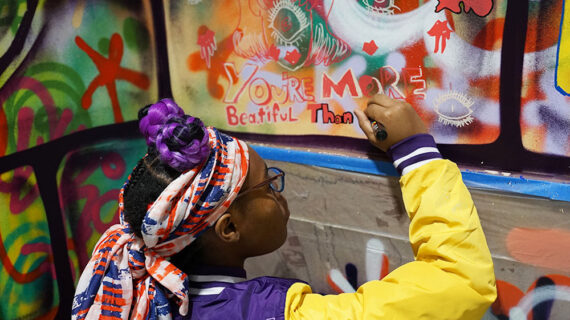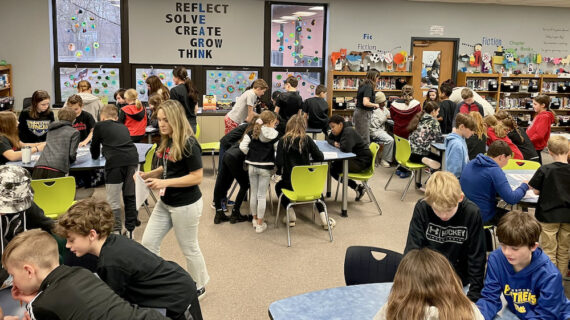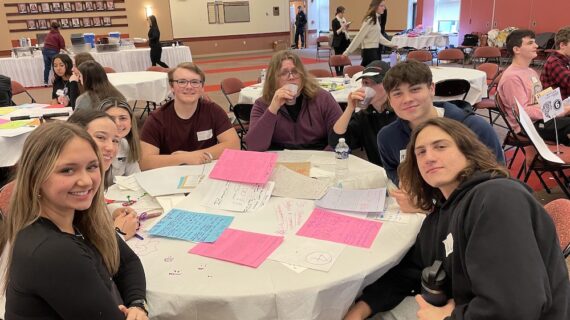
In the Seneca Valley School District, meeting every student’s needs — even from miles away
This story is one in a series created in collaboration with the AASA Learning 2025 Alliance to celebrate the work of groundbreaking school districts in the Pittsburgh region. Kidsburgh will share these stories throughout 2024.
The student was going to drop out.
He’d moved to California to pursue his dream: becoming a professional rapper. And as his career took off, he saw little value in earning a high school diploma.
It might have marked the end of his academic story. But this particular student had come from Seneca Valley, a school district some 2,000 miles from California. There, in the suburbs north of Pittsburgh, officials hatched a plan to see the student through — ensuring that he’d not only earn a diploma, but that he’d graduate with the skills he’d need to thrive in the music industry.
“One of the things we’re proud of is that we serve more than 7,000 kids, and we work really hard to identify the needs of every single one,” says Sean McCarty, Seneca Valley’s assistant superintendent for grades K-6. “And we’re willing to break some things — including some structures that have been around for years — in order to make that happen.”
In the elementary grades, for example, Seneca Valley has shifted away from traditional letter grades, relying instead on reports of student progress that reveal a student’s trajectory: his or her journey from exposure to mastery and everything in between. Rather than simply receiving, say, a C in reading — which tells a student very little about what went well and what could be improved — Seneca Valley’s detailed reports allow teachers, students, and families to have richer, more meaningful conversations about learning.
The reports also help educators tailor the school day to students’ individual needs. Every Seneca Valley student — including English language learners, students with special needs, and those in general education classes — qualifies for targeted interventions.
“Much like in medicine, we can prescribe the best intervention to help with a specific skill,” says Marie Palano, Seneca Valley’s assistant superintendent for curriculum and assessment. “So, instead of saying, ‘This student is struggling with reading,’ we can say, ‘Here is exactly what’s giving this student trouble. And here are the strategies we’ll provide, backed by research, to help this student thrive.’”
This willingness to experiment and innovate, officials say, led Seneca Valley to join the Western Pennsylvania Learning 2025 Alliance, a regional cohort of school districts working together — with support from The Grable Foundation — to create student-centered, equity-focused, future-driven schools. Led by local superintendents and AASA, The School Superintendents Association, the Alliance convenes to help districts like Seneca Valley do what they do best: prepare every learner for tomorrow.
Sometimes, that means offering different approaches to school. For 15 years, for example, Seneca Valley has run an in-house cyber program — one that today enrolls some 200 fully virtual students alongside many more who take select courses online. Dubbed the Seneca Valley Academy of Choice, this virtual-or-hybrid arrangement allows maximum flexibility for the learners who need it most.
“A parent might come to us and say, ‘My child is a top-notch gymnast, and she needs space built into her morning so she can pursue that,” explains Matt McKinley, the district’s assistant superintendent for grades 7-12. “We have another student who’s playing professional hockey. His team’s in Vancouver, but he’s still with us as a full-time cyber student.”
For these learners — and others who, for various reasons, may not feel comfortable or able to attend in-person courses — Seneca Valley recently opened a drop-in center located in the heart of the district’s most-populated area. The center offers a place for Seneca Valley’s hybrid and cyber students to meet their teachers, receive tutoring, do science experiments, and attend holiday celebrations, and more.

The goal, officials say, is to help students pursue what matters most to them — whatever that happens to be. The district even offers “advanced experiences” and “customized learning” programs not unlike the independent study courses that students take in college.
“Students work with teachers to develop learning targets and an individualized learning plan that spans a semester or even a full year,” McKinley explains. Those plans might include internships, apprenticeships, or other job-shadow opportunities: Students interested in teaching, for example, can shadow teachers in the district’s elementary schools.
For the Seneca Valley student who’d moved to California, these offerings proved more valuable than dropping out. Working with a team of teachers and principals to create a customized learning plan based on the music business, the aspiring rapper was able to keep recording — and earn enough credits to graduate.
“That’s what we mean when we say all students,” says McCarty. In the Seneca Valley School District, “we’ll find a way to meet their needs — even if it means looking beyond the four walls of our schools.”
Want to download this story? Click here for a PDF.











